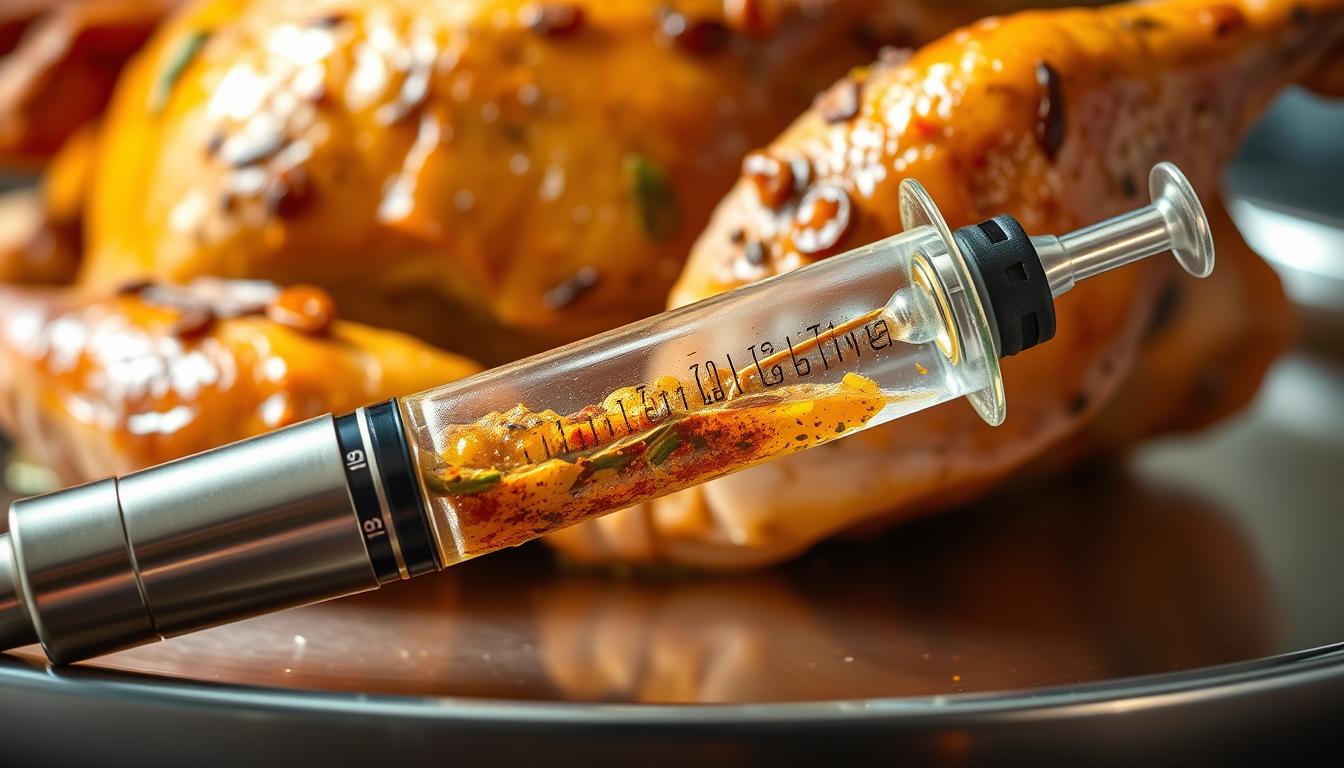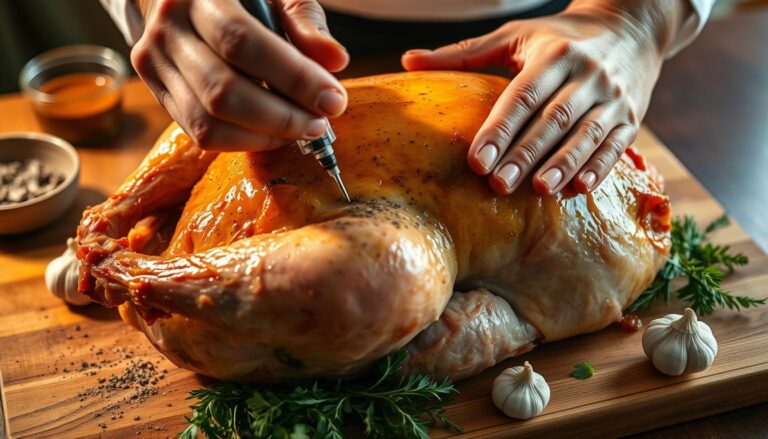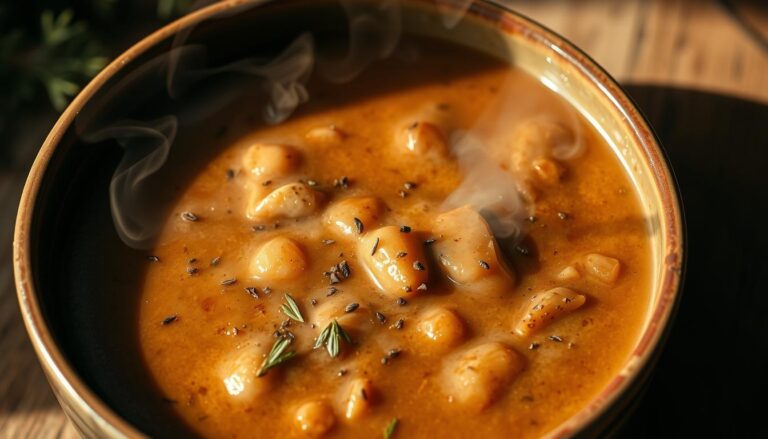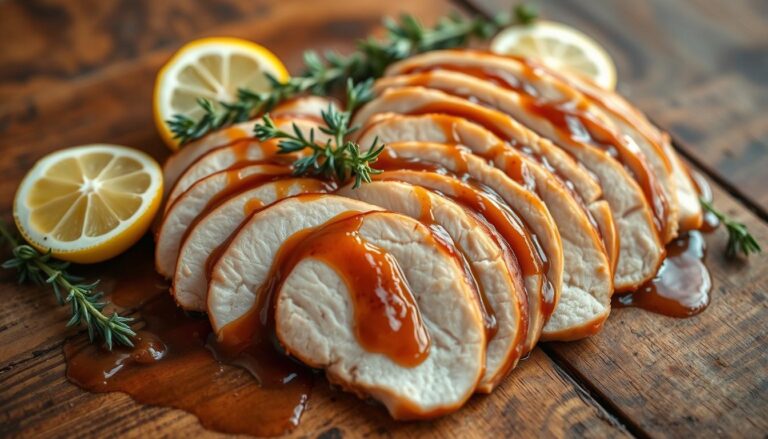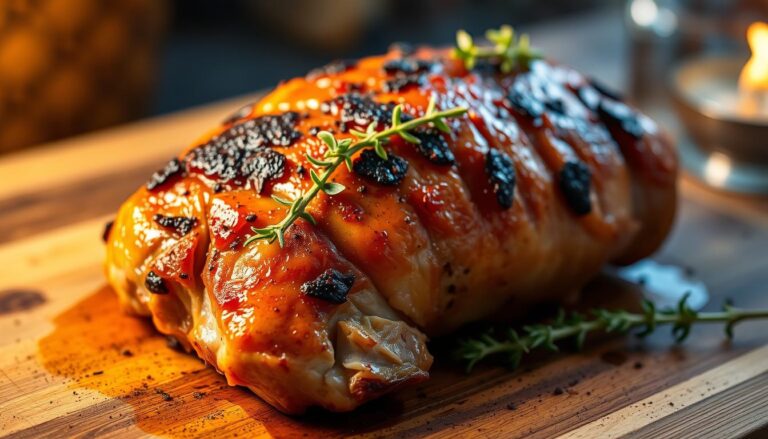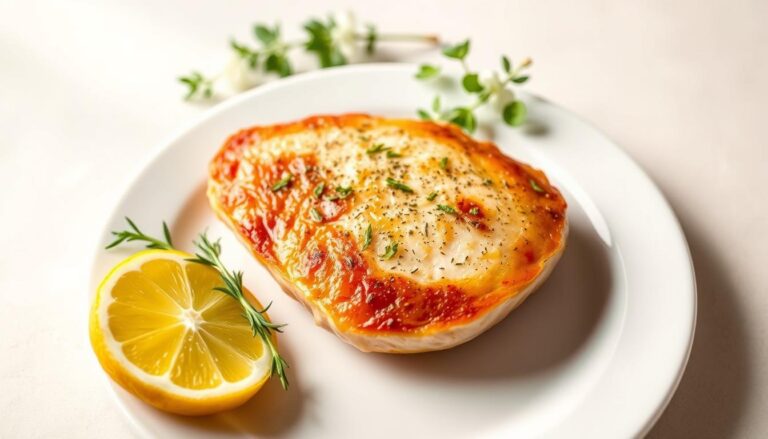Make Your Turkey Shine with Turkey Injection Marinade
You want your next feast to feel warm and unforgettable. Maybe you remember a dry slice that disappointed you, or the proud moment when everyone praised your cooking. This guide is for those moments. It will help you transform a simple bird into a juicy centerpiece.
Using melted butter, stock, herbs, and a touch of citrus gives depth and keeps meat moist. That burst of flavor comes from injecting small amounts into the breast and thighs, then chilling so the tastes spread evenly. You’ll learn a clear, safe recipe and when to strain or swap lemon for apple for a sweeter finish.
By the end, you’ll feel confident handling the injector, timing refrigeration, and pairing your bird with classic sides for a memorable meal. Follow this plan and your thanksgiving turkey will shine with juicy, seasoned perfection.
Table of Contents
Why You’ll Love This Turkey Injection Marinade
This method forces flavor where it matters, so every slice is juicy from the center out. It delivers moisture and seasoning deep into large cuts, unlike surface treatments that only reach a thin layer.
Juicy meat, bold flavor, less prep time than brining
You get fast, reliable juiciness because the liquid goes inside the meat. That means no long soak and fewer hours spent planning.
Bold taste from the first slice comes from butter, aromatics, and spices traveling straight to the breast and thighs. Optional carbonated beer helps lock in moisture for an even richer result.
Perfect for Thanksgiving turkey and weeknight birds
This approach suits a full holiday bird and smaller poultry pieces. You can inject right before roasting or up to 24–48 hours ahead to save prep time and stress.
- Avoids bland centers by beating the shallow penetration limit of surface sauces.
- Scales easily so you can repeat your favorite house blend every season.
What Is a Turkey Injection Marinade?
Think of an injector as a syringe that bastes the interior, giving every slice steady seasoning and moisture.
A turkey injection is a seasoned liquid you push into the muscle so the center stays juicy and flavored as it cooks. Surface rubs and typical marinades rarely penetrate more than a centimeter, which leaves the interior bland.
Brining works differently: it alters water content and seasons near the surface. You can pair a light brine with an injection recipe if you cut salt and match flavors. That combo gives both moisture and deep taste.
How the process works
Prep the liquid like steeping tea. Melt butter or warm stock with herbs and spices, let it rest, then strain. Cool to warm room temperature before you fill the syringe to avoid clogs and to protect texture.
“Injected flavors baste from within, so roasting, smoking, or frying keeps the interior moist through the whole cook.”
- Inject to place ingredients where surface methods can’t reach.
- Strain and cool the liquid for a smooth, clog-free injection.
- Adjust aromatics and heat to create a custom injection marinade.
| Method | Depth of Flavor | Main Effect | Best Use |
|---|---|---|---|
| Surface Rub | ~1 cm | Skin and outer layers seasoned | Quick flavor, crispy skin |
| Brine | Surface to near-surface | Moisture retention, mild seasoning | Whole birds, longer prep |
| Interior Injection | Deep muscle | Bastes from within, strong interior flavor | Roast, smoke, fry |
| Brine + Injection | Surface + deep | Best of both when balanced | Holiday birds, layered flavors |
Ingredients You’ll Need for Maximum Flavor
Gather the right building blocks before you heat the pan. Start with a clear plan so your liquid has body, depth, and a touch of brightness. That makes it easy to scale by cup or teaspoon when you cook for friends or a crowd.
Core liquids and body
Choose a base like melted butter or chicken stock for fat and mouthfeel. You can swap part of the stock for amber ale or apple cider to add seasonal aroma without losing richness.
Savory boosters and umami
Layer in Worcestershire sauce, chicken bouillon or Better Than Bouillon paste, and low-sodium soy to deepen flavor. These helpers add savor without pushing salt too high when combined with a brine.
Spices, herbs, and sweet-tart accents
Use garlic and onion powder, thyme, sage, paprika, a pinch of cayenne, and black pepper for balanced warmth.
Add lemon juice with honey or brown sugar to round flavors and encourage browning as the meat cooks.
“Butter adds silk; stock adds subtle backbone—together they make a liquid that travels through muscle and stays there.”
- Keep herbs finely ground so the syringe flows smoothly.
- Mind salt levels: choose low-sodium components if you also brined.
- Measure confidently: example mix below scales easily by cup and teaspoon.
| Example Mix | Amount |
|---|---|
| Unsalted butter | 1/2 cup |
| Chicken stock | 3/4 cup |
| Lemon juice | 2 tbsp |
| Worcestershire sauce | 3 tbsp |
| Brown sugar & salt | 2 tbsp & 2 tsp |
Tools and Gear: Meat Injector, Needles, and Kitchen Setup
Start with the right tool. Pick a stainless-steel meat injector that cleans easily and will last season after season. A dishwasher-safe body and interchangeable tips make prep and teardown simple.
Match needle type to your liquid. Use multi-hole needles for thin broths and wider tips for butter-rich solutions. Grind dried herbs fine and strain the liquid through a fine-mesh sieve to avoid clogs.
Set up your kitchen with a roasting pan or large cooking bag to catch drips and protect counters. Keep extra O-rings or washers on hand—these wear out and can reduce suction.
- Assemble the syringe and test the plunger with a bit of liquid to confirm smooth action and no air draw.
- Use room-temperature or warm liquid so it flows cleanly through the needle.
- Have paper towels ready to dab any seepage without smearing seasoning.
“Good gear and a tidy setup cut mistakes and let you focus on flavor.”
Step-by-Step: Make the Injection Marinade on the Stove
Preparing the liquid on the stove sets the foundation for even flavor. Start with a calm, controlled cook so the blend stays smooth and ready for your syringe.
Start at the stovetop: slowly melt 1/2 cup butter over medium heat. Whisk in stock, lemon juice, Worcestershire, a touch of sweetener, garlic, and other seasoning until the mixture is cohesive and fragrant.
Melt and steep: infuse fat and aromatics
Bring the mix to a gentle simmer for a few minutes so spices bloom. Remove from heat and let it steep for about 8–10 minutes to develop rounder flavor.
Cool, strain, and prepare to load
Strain the warm liquid through a fine mesh sieve to remove any solids that could clog needles. Aim for a pourable consistency; if the butter firms, rewarm gently over low heat until fluid again.
- Use a tall container so you can draw full pulls with minimal air.
- Confirm the temperature is near room (70–75°F) before loading; chilled blends can clog seals.
- Keep a little extra on hand—some liquid will seep from injection points as you work.
“A warm, strained liquid loads cleanly and disperses evenly in meat.”
How to Inject a Whole Turkey Like a Pro
Begin with a steady hand: load your syringe, purge trapped air, and set the bird in a roasting pan or foil tray to catch drips.
Fill and purge — draw warm, strained liquid into the syringe, hold it with the needle pointing up, and press the plunger slightly to expel air. This ensures consistent dosing and avoids sputtering when you press.
Target the meaty zones: work the breasts, thighs, and drumsticks. Steer clear of thin wing tips and obvious bone areas where liquid tends to leak back out.
Technique and pattern
Insert the needle fully into each muscle, then slowly withdraw while depressing the plunger so the liquid deposits along the track. Use a grid-like spacing over each large muscle to avoid pooling.
Rotate angles from the same entry point to reduce surface punctures and help the liquid bond with the turkey meat fibers.
- Wipe seepage with paper towels as you go.
- Work methodically and avoid overfilling one spot.
- Keep a clean meat injector on hand and change positions every few passes.
“Insert deeply, pull back slowly, and let the liquid stay inside the muscle—not on the surface.”
Timing Guidelines: When to Inject and How Much to Use
A smart timeline gives you juicy results without last-minute panic. Plan so flavors spread, juices set, and food safety windows are respected.
Right before cooking vs. 24–48 hours ahead
You can inject moments before cooking if you need speed. The liquid will baste from inside as the bird roasts.
For deeper melding, inject 24 hours ahead. Many cooks rest the bird up to 48 hours refrigerated with great results.
Suggested volumes and storage
Approximate amounts: plan about 2 cups for a whole turkey and 1/2–1 cup for a single breast. Adjust by size and appetite.
Store any prepared liquid in an airtight container in the fridge. Rewarm gently until pourable before loading to avoid clogs.
- Watch seepage; redistribute rather than forcing more liquid into a saturated area.
- Pat pooled juices dry before seasoning skin for a crisper finish.
- Keep the bird chilled until it goes into the oven to stay within safe time frames.
| When | Effect | Typical Volume |
|---|---|---|
| Just before cooking | Fast, inside basting during roast | 0.5–2 cups |
| 24–48 hours ahead | Flavors settle deeper | 2 cups for whole turkey |
| Storage tip | Keep in sealed container, rewarm gently | N/A |
Turkey Injection Marinade Variations You Can Try
Small swaps in liquid and spice turn one injection recipe into many distinct flavors. Pick a base, strain well, and taste small batches until the blend fits your table.
Beer and butter for extra moisture
Amber ale + melted butter gives toasty depth and richer mouthfeel. Add Worcestershire, a dash of hot sauce, honey, and soy for umami and balance.
Apple cider and herbs for sweet-savory notes
Swap the beer for apple cider and fold in fresh thyme and sage. Add a splash of lemon juice to brighten the finish.
Cajun or Creole for a spicy kick
Toss in Cajun seasoning and a pinch of cayenne pepper. Balance heat with honey and include garlic and black pepper to round the profile.
Citrus, bourbon, or teriyaki twists
Zest lemon or orange, or add a shot of bourbon for warmth. A teriyaki-style sauce works if you strain it well to protect the needle.
“Grind herbs fine and strain. Small tests save big mistakes.”
- Keep soy and Worcestershire for depth.
- Grind spices finely and always strain the mixture.
- Test tiny batches so your recipe becomes a family favorite.
Brining vs. Injecting: Pick Your Path to Juicy Turkey
Pick the method that fits your schedule and flavor goals so every bite stays juicy and balanced.
When to choose one method over the other
Brining adds moisture and mild seasoning through diffusion. It works best when you have time and want an evenly hydrated bird with subtle flavor throughout.
Injection delivers bold flavor deep into the meat quickly. Use it when you need fast, inside-out seasoning without days of prep.
If combining, how to reduce salt and align flavors
Combining both can yield great results, but reduce added salt in the syringe liquid to avoid over-seasoning.
Match flavor families—citrus with herbs, or smoky and savory—so the external soak and interior boost complement each other.
- Short on time? Choose injection for quick impact.
- Want gentle, overall moisture? Brine and finish with a butter rub.
- Combine carefully: cut salt in half for the liquid you inject and test a small batch of the recipe first.
| Method | Primary Benefit | Best Use |
|---|---|---|
| Brine | Even moisture, light seasoning | When you have 12–48 hours |
| Injection | Deep, fast flavor | When time is limited |
| Combined | Layered moisture and interior flavor | Reduce salt; match seasonings |
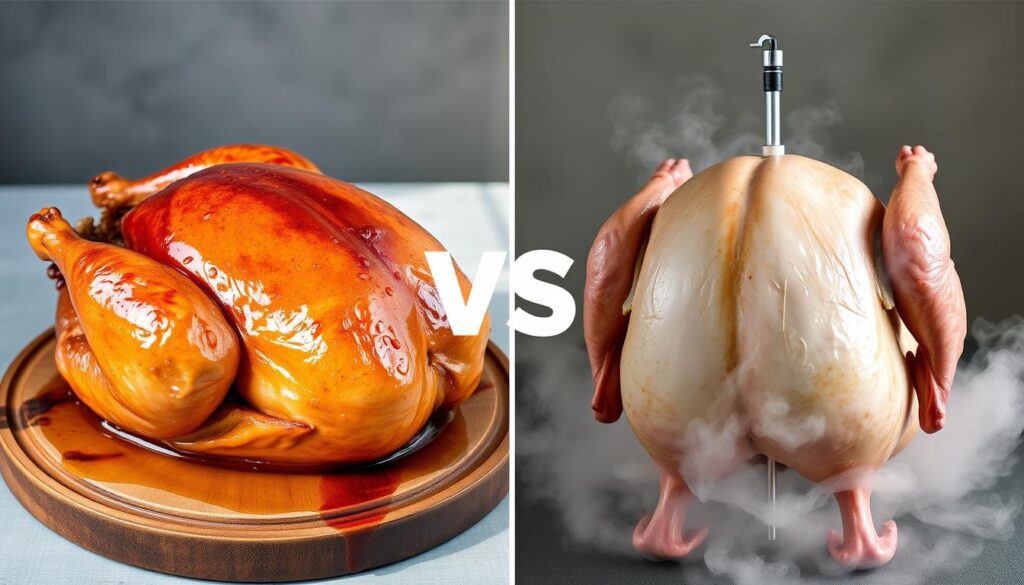
“A thermometer-led cook to proper doneness is key to a juicy result.”
Food Safety and Handling Tips You Must Follow
A few simple rules in the kitchen stop bacteria from undoing your hard work.
Discard any liquid drawn back into the syringe after it touches raw turkey or chicken. Do not reuse that liquid. Throw it away to avoid cross-contamination and foodborne illness.
Cool hot injection liquid for several minutes until it is near room temperature before loading the syringe. Let it rest long enough so the seals and needles are protected and the texture stays stable.
Store unused, untouched liquid in a clean, airtight container in the refrigerator for about a week, or freeze batches up to three months. Thaw frozen portions in the fridge and reheat gently until pourable.
You can rewarm butter-based blends for 20–30 seconds in the microwave or slowly on low heat so fat liquefies without separating. Follow USDA guidance and keep foods out of the danger zone during prep and resting time.
- Keep surfaces sanitized and wash hands between raw and ready-to-eat tasks.
- Label containers with date and contents so you track freshness confidently.
- Avoid leaving prepared liquids or the bird at room temperature for extended minutes.
“Safe handling is the final ingredient that protects flavor and your guests.”
Cooking Methods That Shine with Injected Turkey
Choose a cooking path that highlights the flavor you built. Roast for classic browning, smoke for deep aromatic notes, or fry for dramatic, crisp skin. Each method pairs differently with the liquid you used.
Roasting gives reliable results. Place the bird in a pan when you work and use an instant-read thermometer to reach 165°F in the breast. That ensures safe, juicy meat and consistent results.
Smoking calls for low, slow heat. Let wood like applewood or hickory complement your blend. The interior injection keeps the turkey meat moist while smoke builds depth.
Frying uses high heat to crisp skin quickly. The internal liquid protects the center from drying out. Manage heat so fat from the mixture bastes, but does not burn near hotter zones.
You can brush leftover butter-forward liquid on the skin, then apply a dry rub before or after based on preference. Amber ale pairs well if you want a toasty, malty note.
“Use a thermometer, choose smoke that matches your flavors, and mind heat so fat helps, not harms.”
| Method | Primary Benefit | Key Tip |
|---|---|---|
| Roast | Even browning and reliable doneness | Roast to 165°F in the breast; rest 20 minutes |
| Smoke | Deep smoky flavor, slow penetration | Use applewood or hickory; keep low heat |
| Fry | Ultra-crisp skin, fast cook | Control oil heat; rely on internal liquid for juiciness |
Serving Ideas and Sides to Pair with Injected Turkey
A well-chosen lineup of sides makes each savory slice sing and keeps your meal balanced.
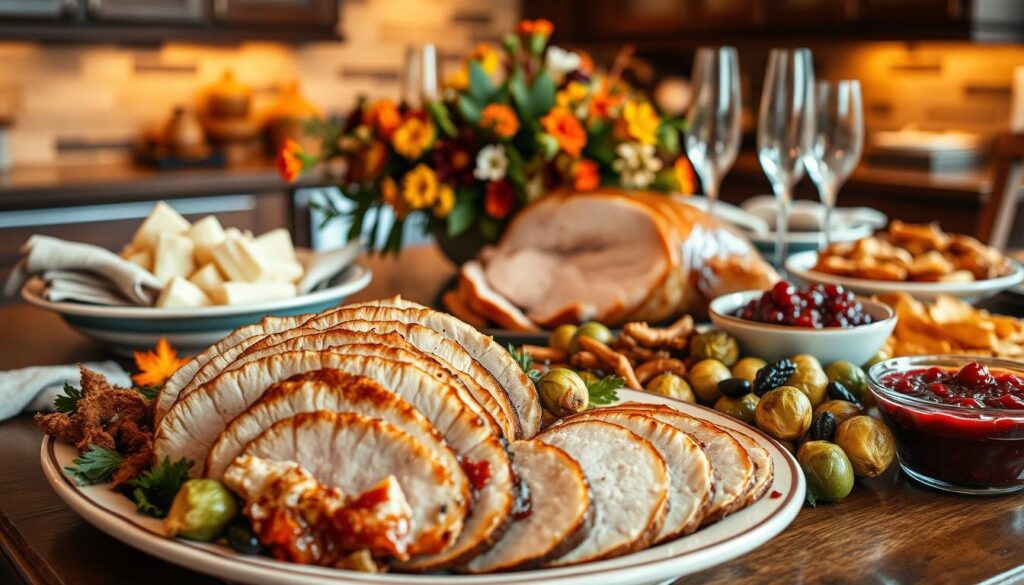
Classic sides to build your plate
Round out your plate with green bean casserole and a savory stuffing. These dishes hold up well while you carve and they complement the rich, juicy slices.
Add a tangy cranberry sauce to cut through buttered meat and add brightness. These familiar choices help guests feel at home and pair with many flavor profiles.
Sweet finishes and final touches
Finish the meal with a sweet potato casserole or a warm pecan pie for a comforting end. These desserts echo the holiday spices and reward the savory course.
- Match sides to your flavor profile—apple- or herb-forward injections work with apple-sided recipes and herb garnishes.
- Plan textures: balance crisp, creamy, and sauced elements beside the tender bird.
- Garnish with fresh herbs from your injection blend for visual and aromatic cohesion.
“Map your serving order so hot dishes reach the table as the meat is sliced; timing keeps each side at its best.”
Conclusion
When you master a clean, strained liquid and a steady hand, the result is reliably juicy and flavorful.
Strong, repeatable technique makes this the easiest way to lift a simple roast into a standout centerpiece.
You now have a clear recipe and safe handling tips. Use about 2 cups for whole birds or ½–1 cup for a single breast. Roast, smoke, or fry to 165°F and discard any contaminated leftovers.
Taste and tweak the marinade—beer, apple-cider, Cajun heat, or citrus—without changing the method. This turkey injection recipe lets you lock deep seasoning inside the meat so each slice shines.

